Today, in every store you can buy different varieties of tomatoes. However, there is nothing tastier than your own garden-grown tomatoes. But in order for them to be tasty and ripe, it is necessary to choose the right soil for them, because in this regard they are very capricious. As you know, this crop can be grown both in open ground and in a greenhouse. The latter option is suitable for growing in large quantities and sending for sale.
Even inexperienced gardeners know that different crops should not be planted side by side. It is advisable to alternate them, otherwise one vegetable will accumulate diseases of the other, as a result of which both may die. It should be noted that tomatoes will be quite comfortable in the beds where cucumbers, carrots or zucchini previously grew. If nightshade trees grew in the intended place, then only after 2 years can tomatoes be planted there.
So, when choosing soil for tomatoes, you need to remember the following rules:
- This culture does not tolerate soil with a high content of organic matter. It is better to give preference to phosphate, potash or nitrogen fertilizers.
- In no case should crowding be allowed, so tomato bushes should be planted at a distance of 50-60 cm.
- Too wet soil is not suitable for these vegetables, so watering should be moderate.
- Soil for tomatoes should be prepared in the fall. Seeds should be planted in loose and warm soil. It should also be either neutral or slightly acidic. Sour can not be, as it will harm the plant.
- You also need to remember that these vegetables should be transplanted only in the evening or in cloudy weather.
Only with this approach can you grow a rich crop of tomatoes.
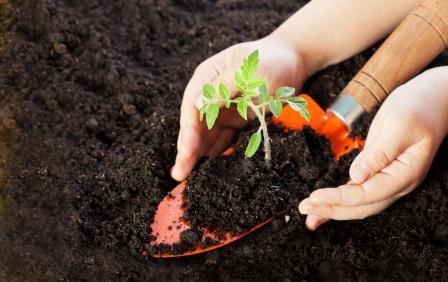 Speaking about what kind of soil tomatoes love, you need to understand how you can achieve the required conditions. If your site is not quite suitable for growing tomatoes, but you have a great desire, then do not despair, as there is a way out. It is not difficult to create favorable conditions for this culture.
Speaking about what kind of soil tomatoes love, you need to understand how you can achieve the required conditions. If your site is not quite suitable for growing tomatoes, but you have a great desire, then do not despair, as there is a way out. It is not difficult to create favorable conditions for this culture.
It is enough to know such tricks:
- before planting tomatoes, it is necessary to disinfect the soil using a solution of copper sulfate. Thus, it will be possible to reduce the risk of fungal infections;
- when choosing a place for planting, you need to avoid those where potatoes or eggplants previously grew;
- if the soil is too acidic, then this can be corrected with liming;
- in order for tomatoes to be resistant to various infections and pests, it is necessary to feed them with chicken droppings, rotted manure or humus. It is also good to add superphosphate or ammonium nitrate.
By following these simple tips, you can achieve high-quality soil on which tomatoes will grow quickly and safely.
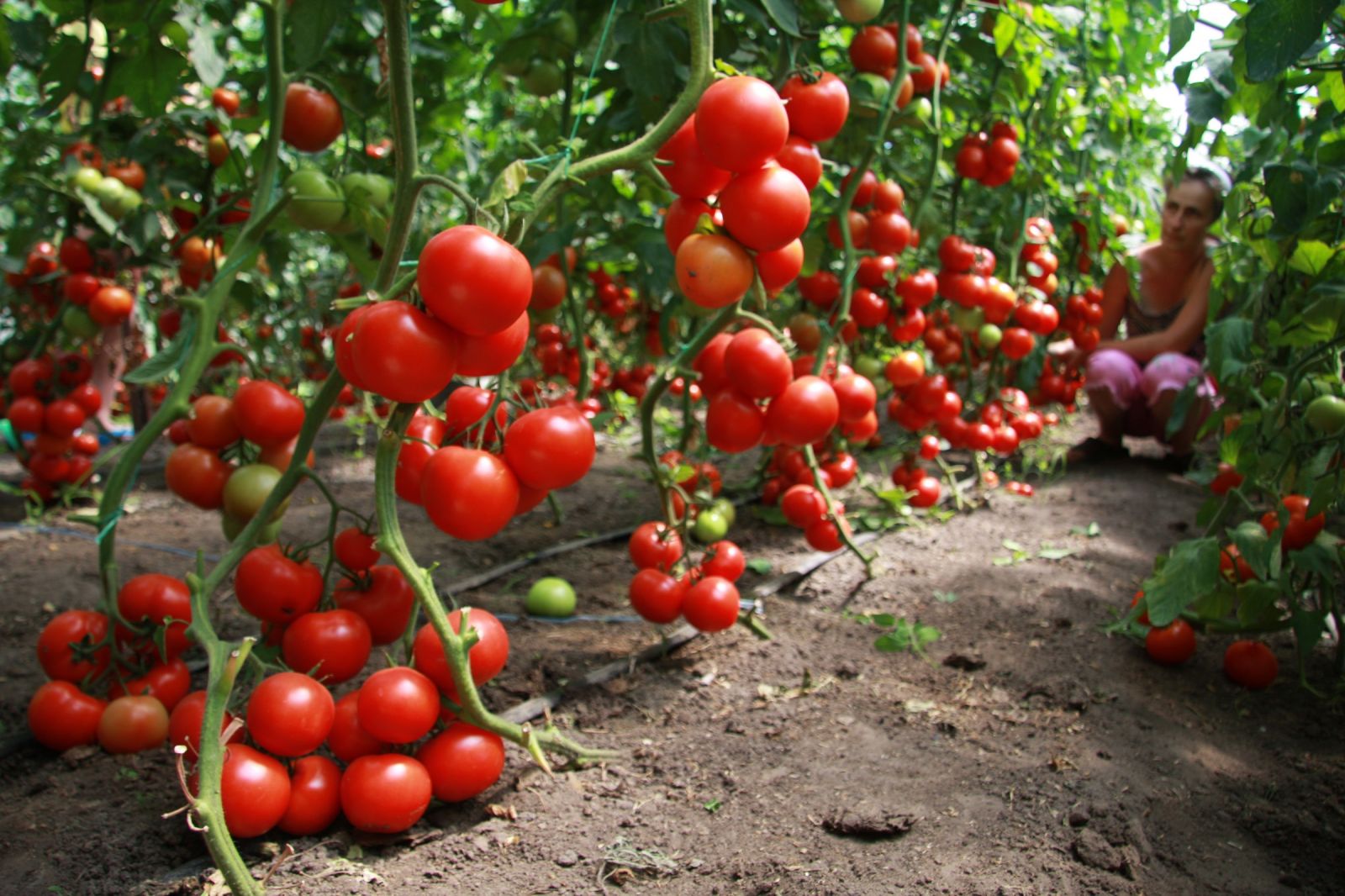 As it turned out, the favorite soil of tomatoes is loose and slightly acidic. Alkaline can also be used. What is wrong with this culture? Note that the lack of light and moisture has a very negative effect on these vegetables, so it is important for them to provide moderate watering and constant illumination. Although they tolerate organics well, an excessive amount is very harmful. You also need to understand that you can’t plant tomatoes in one place every year, because because of this they grow poorly and often get sick. Close planting also negatively affects the culture, so the distance between the beds should be 50-60 cm. It should be remembered that tomato bushes are tall and branched.
As it turned out, the favorite soil of tomatoes is loose and slightly acidic. Alkaline can also be used. What is wrong with this culture? Note that the lack of light and moisture has a very negative effect on these vegetables, so it is important for them to provide moderate watering and constant illumination. Although they tolerate organics well, an excessive amount is very harmful. You also need to understand that you can’t plant tomatoes in one place every year, because because of this they grow poorly and often get sick. Close planting also negatively affects the culture, so the distance between the beds should be 50-60 cm. It should be remembered that tomato bushes are tall and branched.
What disrupts the flowering of tomatoes
Like any other crop, tomatoes are susceptible to various diseases and pests. It must be remembered that if water stagnates in the holes, then the tomatoes begin to hurt. To prevent this from happening, it is necessary to plant them in the lowlands. If a support or garter is used, then the free distance should be 90-100 cm. During the flowering period, fertilize vegetables for 12 days. Watering can be done every other day. If the leaves began to turn yellow, then this indicates a lack of nitrogen. In such a situation, tomatoes should be poured with nettle broth. If the leaves are too red, then they need phosphorus.
When the fruits begin to turn black, this means that the soil is too wet. Rotten fruits must be immediately removed from the garden, so that others do not become infected. After that, the bushes should be sprinkled with potassium permanganate or garlic tincture. These simple tips will help you grow tomatoes the right way and get a rich harvest that will be much tastier than the store-bought version.
Every gardener, sowing vegetable seeds for seedlings, dreams of a good harvest of his favorite tomatoes. But in order to get it, you need to try hard: take care of young plants, water them, feed them, and also pay due attention to the choice of soil. It is the soil for tomato seedlings that plays a leading role in the qualitative development of young seedlings. And only then the turn will come to worry about other nuances: the intensity of watering, the rules for caring for the bushes, as well as top dressing or tying.
It is on what soil is chosen for tomato seedlings that not only the quantity, but also the quality of the future harvest will depend. The soil for tomatoes should be loose, light, well pass air and moisture.
Speaking about which soil is absolutely unsuitable for, there are several main limitations:
- the land in the tomato garden should not be oversaturated with various fertilizers;
- high acidity of the soil is not allowed;
- the soil under your tomatoes should not be overdried or, conversely, overly flooded with water;
- tomatoes do not like cold soil, as well as those soil mixtures that do not warm up well and do not let air through.
When planning to grow tomatoes, do not forget that soil preparation is an important stage not only for young seedlings, but also for adult plants.
Video "Soil preparation"
From the video you will learn how to properly prepare the soil for planting tomatoes.
Soil for seedlings
The best soil for growing tomato seedlings is land on which nothing has been grown for the past few years or ordinary nettles have grown. If it is not possible to get such soil, you can use the soil from the beds on which zucchini, pumpkins, carrots or cabbage grew. It is important that the plants do not suffer from late blight. In extreme cases, ordinary forest land is suitable. 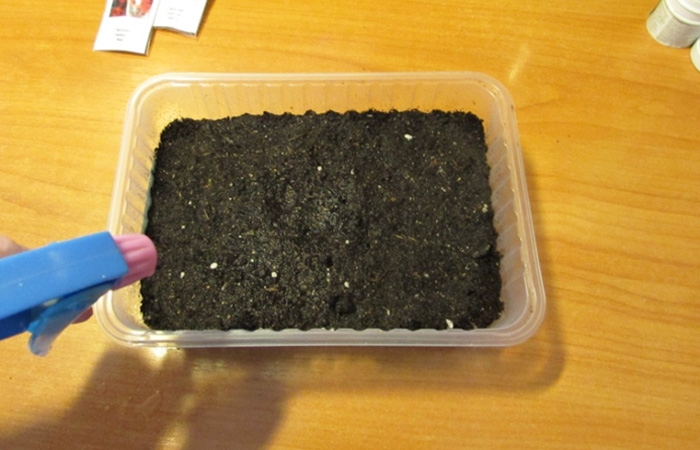
Preparing the soil in a greenhouse for tomatoes in the spring involves a whole range of activities, which as a result should lead to the following set of characteristics:
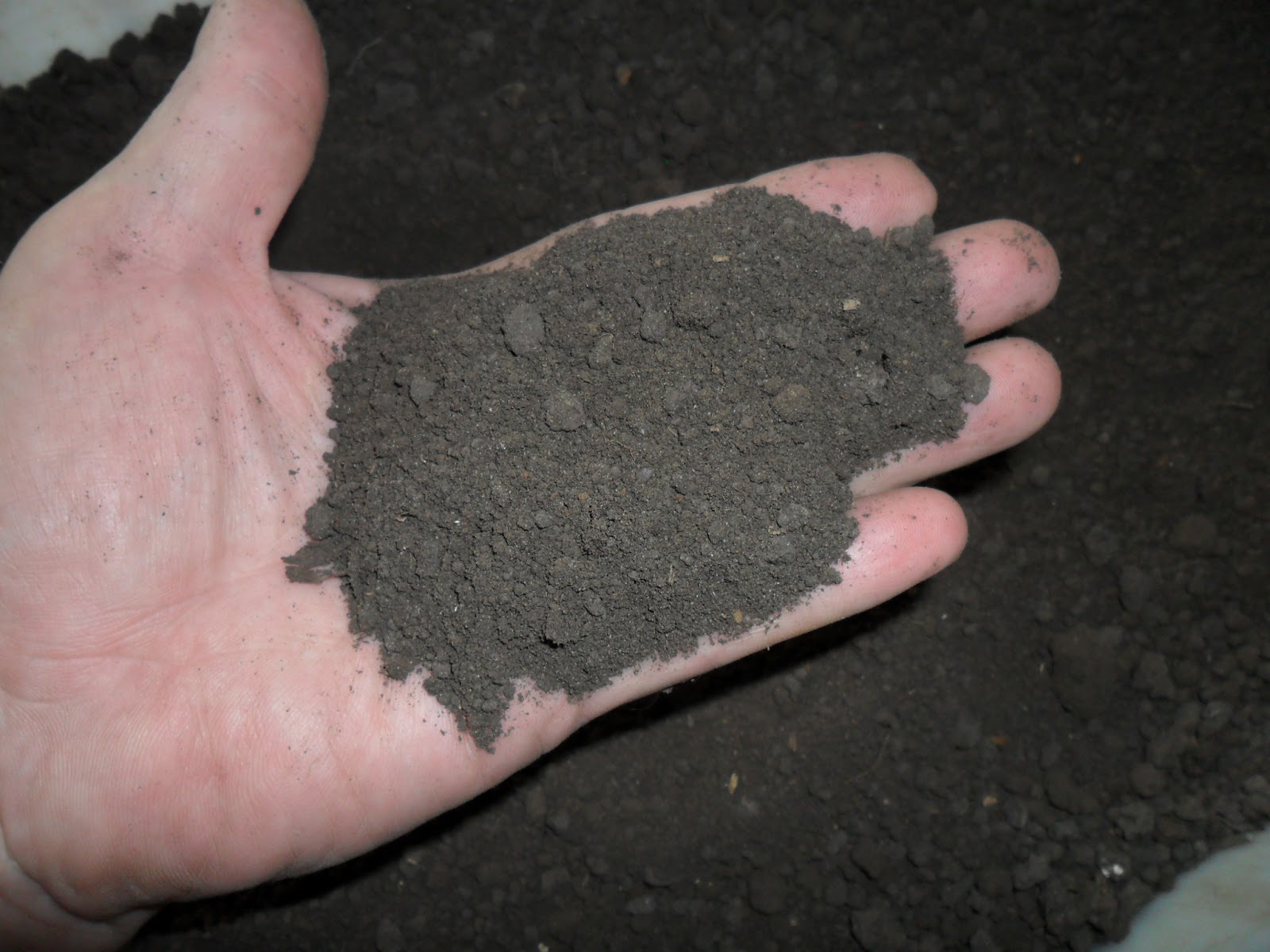
By the way, today in agricultural stores specially prepared soil mixtures are sold, ideal for growing tomatoes. And if it is hardly possible to acquire a sufficient amount of such land for adult plants, then you are quite capable of providing seedlings of tomatoes with it.
But if you do not want to spend extra money on purchasing soil, you can prepare the right mixture yourself. To do this, you will need: peat and turf, taken in a ratio of 3 to 1, sawdust, mullein and peat (1: 3), sand mixed in equal proportions with peat, as well as soil, manure and ash (3: 3) are added to these components. 1). 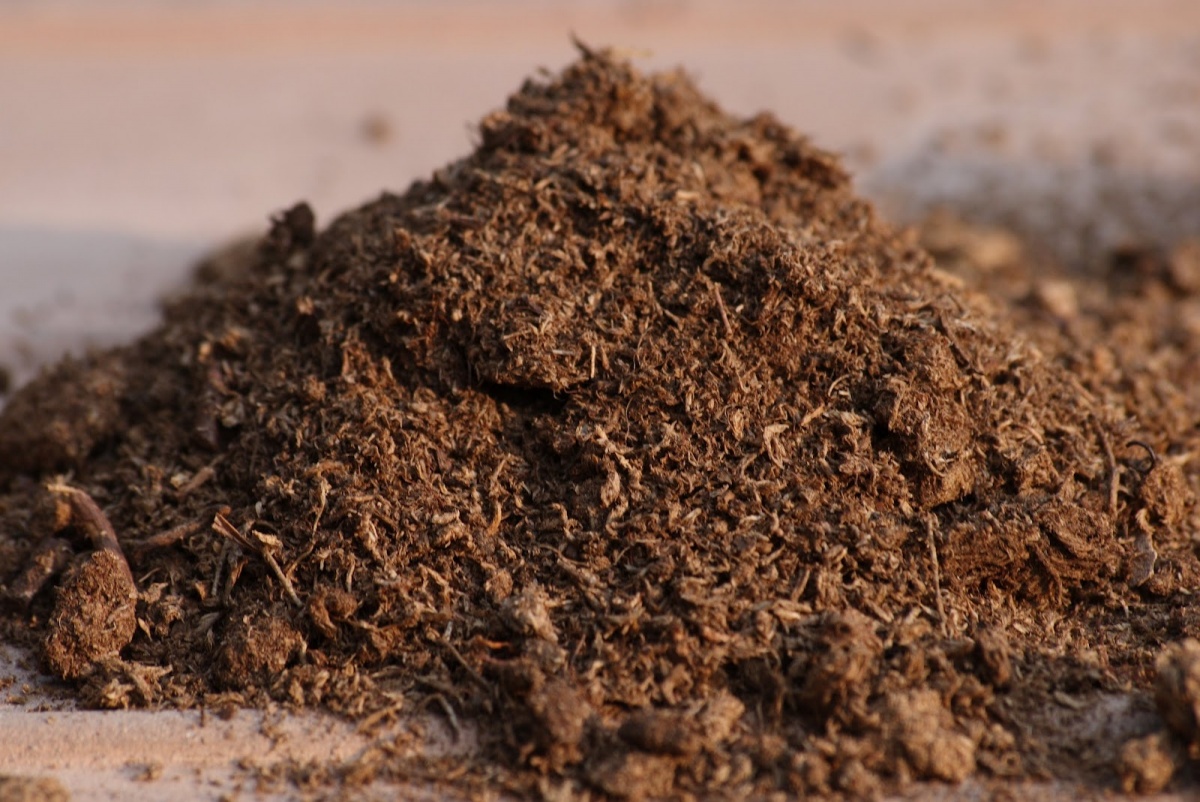 Such a composition is perfect for your tomatoes, they will be able to receive all the necessary nutritional components, fully develop, in order, in the end, to please you with a generous harvest.
Such a composition is perfect for your tomatoes, they will be able to receive all the necessary nutritional components, fully develop, in order, in the end, to please you with a generous harvest.
Soil preparation for seedlings
In order for the seedlings to feel good and develop quickly, it is not enough to prepare a suitable soil mixture, it must also be properly prepared. To do this, you have to go through several stages:
As soon as the earth finally warms up, compost, urea or manure must be added to it.
You can add a small handful of wood ash and a little superphosphate to the mixture, according to the recommendations on the product package.
The next step is treatment with a weak solution of potassium permanganate, at the rate of 3 grams of crystalline powder per 10 liters of water. Or you can refuse this procedure and just steam the earth - for this, a dense fabric is pulled over a large saucepan, the earth is poured into it and held over boiling water for half an hour.
You can add lime - 15 grams will be enough for every kilogram of soil.
Regardless of which soil you use - bought from a specialized store or prepared on your own, it is better to finish all the preparatory steps in the fall so that the earth can completely freeze during the winter months.
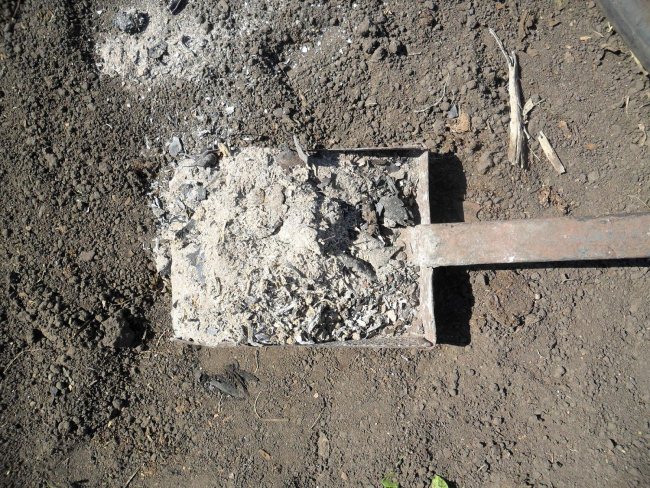 Cold has a disinfecting effect, ridding the soil of possible pests and pathogens that are dangerous for tomato seedlings.
Cold has a disinfecting effect, ridding the soil of possible pests and pathogens that are dangerous for tomato seedlings.
Soil preparation for planting
Preparation is necessary not only for the land in which the seedlings will develop, certain manipulations must also be carried out in the garden where you will plant it. As in the case of seedling mixture, it is better to do this in the fall so that the surface layers of the soil are thoroughly frozen. The main preparatory manipulations consist of cleaning the beds from various debris (both vegetable and mechanical), carefully digging the soil, adding compost and wood ash, and fertilizing the beds. 10 days before the proposed planting of tomatoes in a permanent place, the beds are well watered hot water and cover with foil. After the specified period, you can start landing. 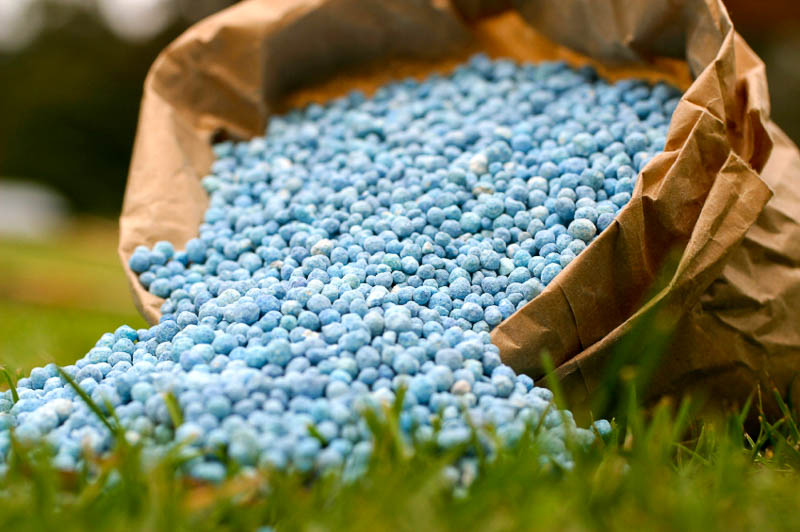
Growing tomatoes in the garden with your own hands is painstaking work. Location, different crop varieties, planting time, moisture level, prepared soil - all this affects the yield and health of the tomato fruit.
Tomato is one of the most demanding vegetable crops. Therefore, in order to plant a tomato in the garden, you will need to study all the subtleties and features of this culture. In order to get a good, healthy and tasty harvest, certain conditions must be observed, the most important thing is that the soil for tomatoes must be well prepared.
Soil preparation

The soil for sowing should contain useful substances, so it must be immediately enriched. Prepare the soil in the greenhouse for the next crop should be after each harvest.
It is best to fertilize the soil in late August and early September.
Soil restoration algorithm:
- 1. Remove from the bed 20 cm of the top layer of the earth.
- 2. Pour humus into this place, which does not contain anything superfluous (for example, straw or hay).
- 3. It is necessary to fill half of the excavated land with humus, then lay a new one.
Warming soil
Organic residues (cut grass, leaves, tops of plants and straw) are introduced into the greenhouse in autumn. This is done so that the soil becomes loose. It is worth noting that sawdust and manure must be laid equally in the soil of the greenhouse. A few months later, in the spring, new earth is filled up. Next, you need to add ash and mineral fertilizers. Pour hot water over it all and cover with foil.
The algorithm for warming the soil for planting is quite simple. You can not plant a tomato in cold ground. The plant will begin to hurt and wither, so only after a week of warming up the soil is it recommended to plant sprouts.
This is the best option for planting tomatoes. To achieve a better result, additional soil preparation is necessary.
Humus to saturate the soil
Invertebrate earthworms are a key link in the ecological chain. Everything that is in the ground passes through them. After mixing with the ground, the soil is saturated with useful and important elements. Everything turns into active biomass after the earthworm absorbs and processes dead organisms and spores. It is necessary to carry out the following procedures for fertilization:
- 1. On 1 square meter you need to collect from 5 to 10 individuals and distribute them evenly around the entire perimeter of the garden.
- 2. After digging a small hole, put the earthworm there and fall asleep.
- 3. Having finished with the worms, it is necessary to water the plantation abundantly with water.
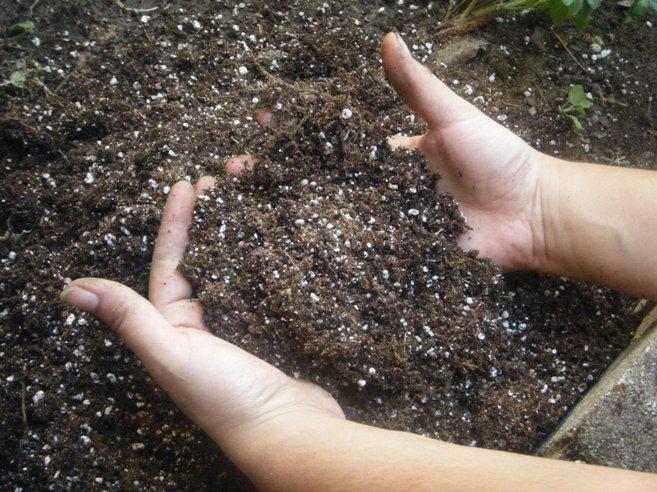
Water must be completely absorbed into the ground. You need to make sure it doesn't freeze.
soil bacteria
The bacterial cocktail contains many useful substances. Their function is to recycle nitrogen. The earth will be saturated, so the yield of tomatoes will be higher.
One ampoule will be enough for 650 sq. m. You can buy a solution in any chain of stores for gardeners. Rules for the use of the drug:
- 1. Dissolve an ampoule of the substance in 2 liters of boiled water.
- 2. Add 1 tbsp. a spoonful of melted honey.
- 3. Pour the mixture into a jar.
- 4. Leave in a warm room for 2-3 months.
- 5. Stir 1 glass of the mixture in 20 liters of water, evenly water the greenhouse.
- 6. A few weeks before planting, water the ground again with such a cocktail.
Mineral elements and organic fertilizers, together with abundant sunlight, give the earth useful properties, which leads to the normal growth of the fetus and the strengthening of its health.
Do-it-yourself soil preparation
Whole substrates are available in gardening stores. They contribute to the good growth of all types of vegetables..
In the absence of the possibility of purchase, you can make a mixture for the soil at home. Instruction:
- 1. Having collected the entire crop, remove all remnants of greenery.
- 2. It is necessary to free the soil from the roots. Dig carefully the soil in the greenhouse.
- 3. You can destroy all possible pathogens with the help of bleach and water (in a ratio of 1:33). After 3 hours, disinfect the wooden and metal part of the greenhouse structure. Spread bleach on the ground with a rake.
- 4. In the spring it is better to apply horse or sheep manure. Biofuel must be spread throughout the plantation in a layer of 30-40 cm and covered with earth.
- 5. Pour the formed beds with warm water. 2 weeks before planting, it is recommended to fertilize the soil with ammonium nitrate.
Reasons for the emergence of "green" soil
Several reasons for the appearance of green soil:
- high humidity in the soil;
- high acidity;
- lack of oxygen;
- abuse of fertilizers.
The influence of these factors on the appearance of green soil:
- 1. Increased humidity level. Moss and algae are more likely to appear in humid environments. Plants germinate at lightning speed in the ground, under which groundwater very often flows. With frequent watering, plants absorb a large amount of moisture.
- 2. High acidity. Moss gains strength and grows due to water, sunlight, carbonic acid and mineral fertilizer. Algae with moss absorb the beneficial properties of the soil. In this case, the normal development of tomato sprouts does not occur. The result is oxidation. You can avoid trouble with the help of wood resin, lime and dolomite flour. You can fertilize at any time. The soil begins to deoxidize, preventing moss from developing.
- 3. Abuse of fertilizers. Phosphorus fertilizers provoke accelerated growth of mosses. When a large volume is introduced into the soil, an inexperienced gardener worsens the vital activity of the soil.
- 4. Lack of air in the greenhouse. Superheated air in the structure causes the germination of mosses. It is necessary to make ventilation. Plants need to breathe fresh air.
Fighting green soil
The greened earth slows down and impairs the growth of the plant, so the following series of actions must be carried out:
- 1. Stop watering for a while.
- 2. Define the problem. When moss appears - give light and fresh air to the earth, algae - close the greenhouse from the sun's rays.
- 3. It is recommended to put sand and sawdust in several layers on the algae.
- 4. The affected layer of the earth must be removed.
- 5. Ventilate the greenhouse.
The acidity of the soil can be of several levels. It is necessary to determine its level:
- in the laboratory of agrochemistry;
- using litmus paper;
- instrument for measuring soil parameters;
- in a folk way (cook currant leaves, throw a little earth from the ground, the color will indicate oxidation, red is sour, green is not, blue is half sour).
Having determined the level, the soil should be deoxidized: peat or wood ash, crushed chalk, lime or dolomite flour.
Replace the top layer of the earth only as a last resort. The procedure is long, but the result is effective. Proper removal of the soil layer:
- 1. Dig a layer of earth 30 cm.
- 2. Cover with lime.
- 3. After a day, extinguish the lime with water.
- 4. After 3–5 days, lay a new layer of soil.
Preparing to plant tomatoes in a greenhouse
Seedlings before transportation must be treated with a substance from diseases. On sunny days leave on the balcony. A few days before planting, cut off 3-4 lower leaves.
The plant needs to be fed with ash (1 cup of ash per 10 liters of warm water). Stop watering a few days before planting. On the day of planting, water the sprouts abundantly. Treat formed buds or open flowers with boric acid.
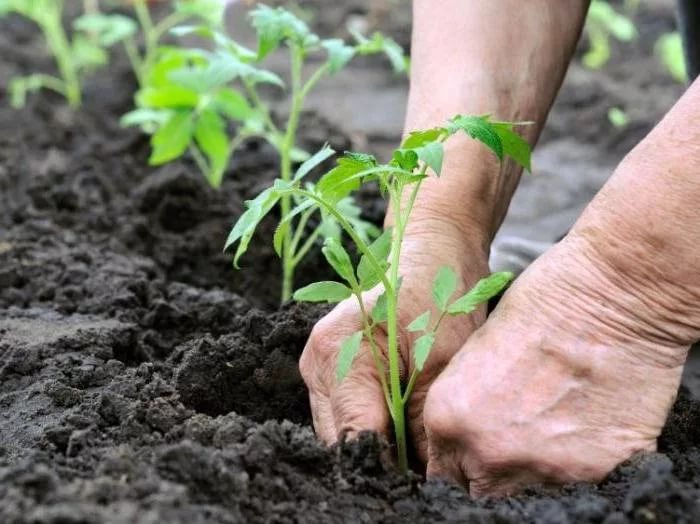
The greenhouse must be prepared in advance. Polycarbonate is used to protect against bad weather. Remove last year's soil by 10–15 cm. The beds should be dug up and weeds removed. Before planting, measure the temperature of the soil, the optimal value should be 15 degrees. If it is below 8 degrees, the plants will not live long.
The clay mixture for planting tomatoes stimulates the successful growth of all planted plants. Such mixtures include: humus, sawdust and peat. Before planting seedlings, the soil must be processed. A solution of copper sulfate, which must be heated to 100-150 degrees. The solution protects against fungal disease. In the morning before planting, it is recommended to cut off all diseased and yellow leaves.
How to make greenhouse beds?
The location of the beds in the greenhouse is best done with the letters "P" and "W", along long walls or in several lanes. The width of the beds is made individually. The approximate value is from 60 to 90 cm. The main requirement is not to plant sprouts less than 50 cm apart. The passage between the beds can be any. Nothing should interfere with the gardener when he takes care of the seedlings.
Tomato beds are made just above the surface. The soil above the ground should be raised, it is this position that can retain heat in a quality manner. Height 20–50 cm.
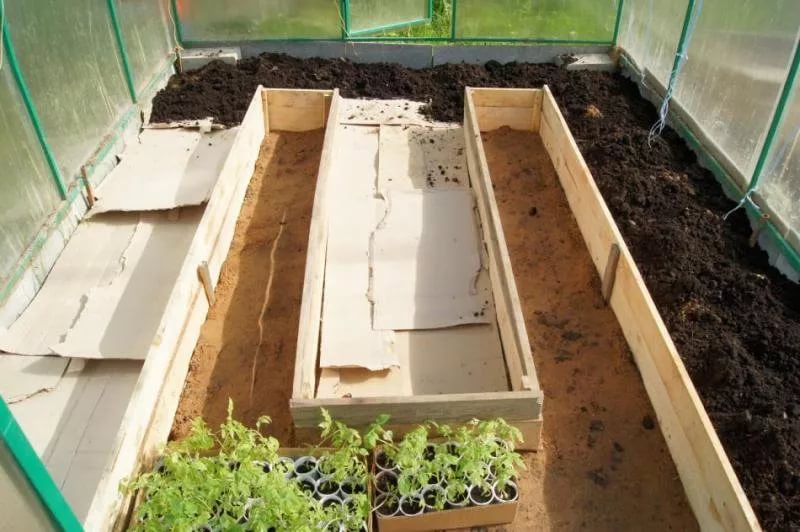
Soil Optimization:
- 1. Clay soil is used for loosening (a bucket of humus, wood sawdust and peat per 1 sq. M of land).
- 2. You can lighten the soil with 1 kg of peat (small chips, humus and sod land per 1 sq. M).
After falling asleep, a home-made optimizer is recommended to be fertilized (1 tablespoon of potassium sulfate per 2 tablespoons of superphosphate) and dig the soil. Before planting, it is necessary to fill in a weak solution of potassium permanganate.
Make holes opposite each other or in a checkerboard pattern with a distance of 50 cm. The drug "Barrier" is used as a prophylaxis. Half a liter is poured into each well.
A large distance between the beds is one of the main conditions, as the plant will branch and it will be comfortable. The formation of stepchildren reduces the yield of all plants. You need to remove them only in the morning, carefully breaking off each branch.
Sequence of planting seedlings
The correct sequence is very important. There is an algorithm of actions that must be strictly followed:
- 1. Cut off the lower leaves.
- 2. Turn the container with seedlings over and carefully remove the sprouts.
- 3. Install them in the prepared hole. The cotyledon leaf should be located slightly above the surface level.
- 4. Fill free space with soil.
- 5. Water the tomatoes and tie them to a wire rack that supports the plant for 12–14 days. Do not water very often.
Strict observance of agrotechnical standards is a 100% guarantee of yield.
Planting tomatoes in the soil of the greenhouse
It is recommended to plant seedlings in prepared soil after lunch. The air is cool, solar activity is reduced. Between the holes of the tomato, the distance is not less than 50 cm and it is recommended to plant it in a checkerboard pattern. Set a peg with each sprout. In the future, you will have to tie up each tomato.
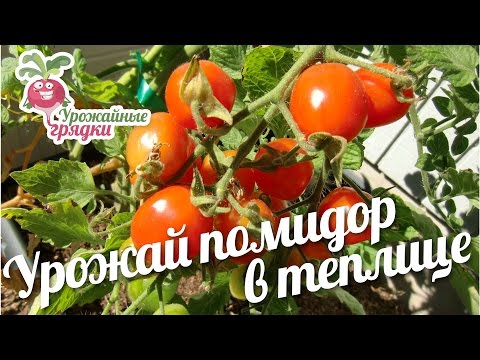
On the labels of tomato seeds, the classification of the tomato variety is often mentioned: determinant, indeterminate and standard. They are divided into several types according to growth and formation of ovaries.
The determinant variety begins to tie from 3-5 leaves to the formation of 5-8 brushes. The growth of the stem is limited, it has a strong and thick stem up to half a meter. An indeterminate variety begins to form its ovary over a 5-7 leaf without interruption.
Ultra-early, determinant and tall varieties are planted in two rows. Near the window there is a row planted with determinant plants, the second row of ultra-early ones. Just as high-speed tomatoes are just starting to sprout, ultra-early ones produce delicious tomatoes.
An early ripening undersized variety is planted in a checkerboard pattern of 30–45 cm in two rows. The determinant and standard varieties are planted much denser. The only downside is that you need to make sure that the sprouts do not thicken. A tall variety is planted at a depth of 15–30 cm.
When transplanting seedlings, you should pay attention to overgrown sprouts. They must be planted according to a different algorithm:
- 1. The plant is placed in a dug hole not vertically, but horizontally.
- 2. A small part of the top should remain on top.
- 3. The lower leaves are cut off, new roots will then grow in this place.
A similar planting option will save an overgrown sprout. The flowers will not fall off and new roots will appear on the stem, which will give life to the tomato.
Fertilizers for seedlings in the greenhouse
Mineral fertilizers contribute to the growth and development of tomatoes. List of necessary fertilizers:
- phosphorus;
- nitrogen;
- potassium.
The root system is completely dependent on phosphorus. Without receiving this type of fertilizer, the plant will not be able to absorb nitrogen. Red-purple spots indicate that the tomato lacks phosphorus.
When growing a tomato in a greenhouse, you need to remember that the use of potassium is essential. Beneficial features minerals contribute to the full formation of the stem, the assimilation and processing of carbon dioxide by the tomato. Potassium starvation will manifest itself in the death of the lower leaves of the plant.
How to do top dressing outside the root?
Foliar top dressing consists in spraying the stem and leaves of a tomato. The main advantage is that all useful substances immediately enter the soil of the greenhouse. With normal feeding, nutrients get only on the leaves, which is insufficient for the full life of the tomato. The result of the manipulations will appear after 2 weeks.
Top dressing can be done with boric acid and wood ash:
- 1. Two glasses of wood ash.
- 2. 3 liters of boiled water.
- 3. Mix the two ingredients and leave to infuse for several days.
- 4. After 3-4 days, the solution must be filtered.
- 5. Add boiled water to the substance so that it is 10 liters.
- 6. Spray the tomatoes with the resulting product.
Deficiency of nutrients in a tomato in a greenhouse
Experts have found out that the appearance of a tomato depends entirely on its health and beneficial minerals:
- 1. Lack of phosphorus is expressed in the appearance of purple streaks. A solution of superphosphate will cure in a few days.
- 2. With calcium deficiency, tomato leaves curl and the plant begins to get sick. Calcium nitrate will fill the deficiency and restore the vital activity of the plant.
- 3. Nitrogen deficiency is characterized by a yellowish green tint, the tomato lags behind in growth development and becomes thin. Urea solution will help to cope with the shortage.
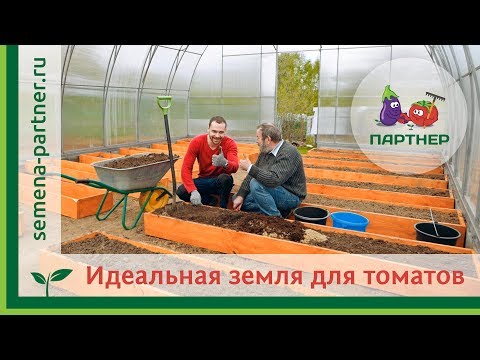
Gardeners believe that foliar feeding is very important for the development of the fetus. The procedure is recommended to be carried out in spring and autumn, only after that start planting tomatoes in the greenhouse.
Tomatoes in the greenhouse area grow very tasty and healthy, if you follow all the rules for caring for them. Make compositions of useful substances, fertilize and feed, monitor appearance and take into account all the nuances of planting - the main requirements for good plant growth.
Tomato (or tomato) is a delicious and very healthy vegetable crop, which is actively cultivated in agricultural complexes on an industrial scale and in summer cottages for their own consumption. At the same time, growing a tomato is far from the easiest task even for an experienced gardener. This vegetable is very demanding on light, humidity, temperature conditions and soil nutrition.
The choice of a suitable variety, as well as properly prepared soil, are practically the main components that affect not only the successful development of plants, but also their yield.
Soil Requirements for Tomatoes
How do you know if yours fits or not? garden plot for growing tomatoes? To get an answer to this question, check out the basic requirements of this culture.
- Tomatoes can grow in almost any soil. Only some will require more preparatory measures, while others will require less. Plants respond best to nutritious and loose soils with good water and air permeability - for example, loam.
- Tomatoes prefer slightly acidic soil. Optimal pH value for this culture should be in the range from 5.5 to 6.5. The value of acidity can be determined by buying a special tool at the agricultural store or by doing an analysis in a soil science laboratory.
- Plants make rather high demands on the temperature regime of not only air, but also soil. It must correspond to the interval from +18 °С to +20 °С.
- Tomatoes are very demanding on soil moisture, as their branched root system can absorb water in fairly large quantities. However, excessive waterlogging can lead to the development of fungal diseases. At the same time, the lack of moisture often causes the flowers and ovaries to crumble, and the fruits grow poorly in size. Low-growing varieties are especially sensitive to lack of water. The optimal value of this indicator is in the range from 75% to 80%.
How to achieve the desired soil quality
If the composition of the soil on your site is far from ideal, and you really want to grow your own crop of tomatoes, do not give up. Creating favorable conditions for the growth and development of tomatoes is a completely doable task if you know a few tricks.
- Before planting, be sure to disinfect the soil with a solution of copper sulfate. This will allow you to reduce the risk of various fungal diseases, which are very susceptible to almost all varieties of tomatoes.
- When choosing a planting site, avoid beds where peppers, potatoes, or eggplants used to grow. Try not to plant tomatoes in the same place, as this will accumulate harmful microflora for them. The best predecessors for this crop are cabbage, cucumbers, any root crops and legumes.
- Clays for tomatoes are too heavy and require additional loosening by adding peat, sandy soils are low-nutrient, and therefore need in large numbers organics, peatlands should be slightly “weighted” with garden soil. And all these soils require the mandatory introduction of compost and humus.
- If the acidity is high, it can be reduced by liming. Excess alkaline reaction is neutralized by sulfate granules.
- For normal fruiting and good disease resistance, tomatoes need a lot of nutrients. The source of organic matter is chicken manure, rotted manure, compost and humus. As mineral supplements, superphosphate and ammonium nitrate should be added. In addition to them, it will be good to add wood ash.
What do tomatoes absolutely dislike?
Beginning gardeners often make various mistakes when growing tomatoes. Here are the most common ones.
Tomato is a common and loved by all culture, which requires proper care and attention during cultivation. The soil for tomatoes and its proper selection will greatly facilitate this lengthy process. What land will be optimal for growing and how best to prepare it?
Tomato is a common and beloved crop that requires proper care and attention during cultivation.
You can grow tomatoes in several types of soil - a mixture of turf and humus soil or in purchased options for vegetables. The approximate composition of the soil should be as follows:
- Humus. Organic fertilizer, compost, decomposing for more than 2 years.
- Peat. Decayed remains of plants and animals.
- Baking powders.
- Leaf land.
- Sand.
The composition for growing tomatoes is made as follows:
- spread polyethylene on the ground;
- add peat and sand to 1 part of the turf, mix thoroughly;
- add nutrient solution.
When choosing soil for tomatoes, pay attention that tomatoes will not sprout or grow incorrectly if:
- The soil with seeds is in the shade.
- The distance between crops is less than 40 cm.
- They need to be filled with water or not moistened at all.
- Acidic soil. In this case, there will be no sprouts at all.
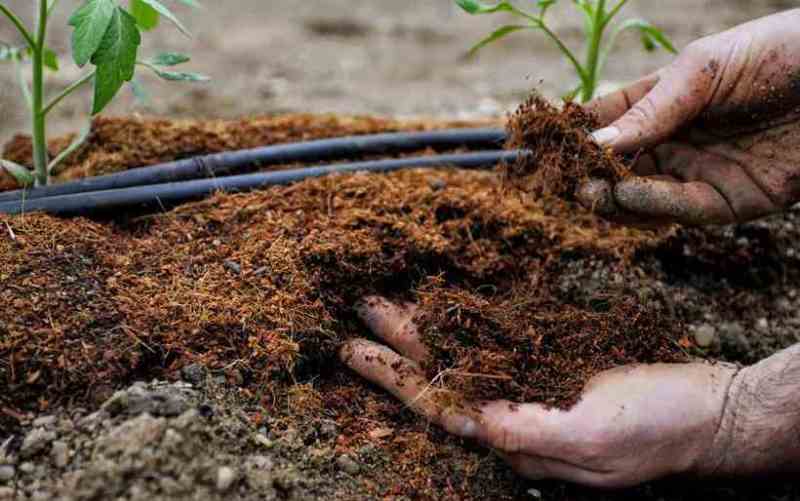
You can grow tomatoes in several types of soil - a mixture of sod and humus soil
Soil preparation begins in the fall. The soil for seedlings of tomatoes should be loose and neutral (slightly acidic is allowed). If the acidity is exceeded, then shoots will not appear on it. Looseness of the soil can be achieved by adding sawdust, peat, a special substrate (shredded coconut fiber) and peat tablets. In addition, the latter significantly save space for seedlings, since several seeds can be sown in them at once.
It is better to store the soil in boxes outside or in a cool room, since all the bacteria contained in the soil die during cold weather. Seeds are planted in shallow holes (about 1 cm) and sprinkled with earth, after which the boxes are covered with foil. The first shoots appear within a week. Immediately after this, it is important to provide the sprouts with sufficient lighting, since the tomato is very picky about proper lighting.
It is worth taking care of the disinfection of the soil. For this use different ways. The best is to freeze the soil, but if possible, they are treated with steam (in a fabric bag for 45 minutes) or disinfectants (for example, a solution of potassium permanganate). Autumn preparation, although not the main part of everything that happens, is no less important for this. Pre-treatment may not be done, but later planting will cause additional problems and costs, so experienced gardeners strongly recommend doing all these procedures before the main process.
Soil for seedlings (video)
Final stages of work and disembarkation
The main work takes place at the end of summer: the soil is dug up in dry weather, and its depth should not be more than 20 cm. Immediately before planting (in spring), the soil has been loosened several times already. Then mineral fertilizers and humus are introduced into the soil, and already during planting, these same components are placed directly in the planting holes. Fertilizers for digging can be both organic (for example, manure - necessarily rotted), and mineral (potassium and phosphorus).
To grow tomatoes, you need to start by sowing seeds, which are transplanted into another soil about 60 days after germination. This process is called crop rotation. It is extremely necessary when planting such a capricious crop as tomatoes, because, remaining in the same place, the fruit will accumulate various diseases.
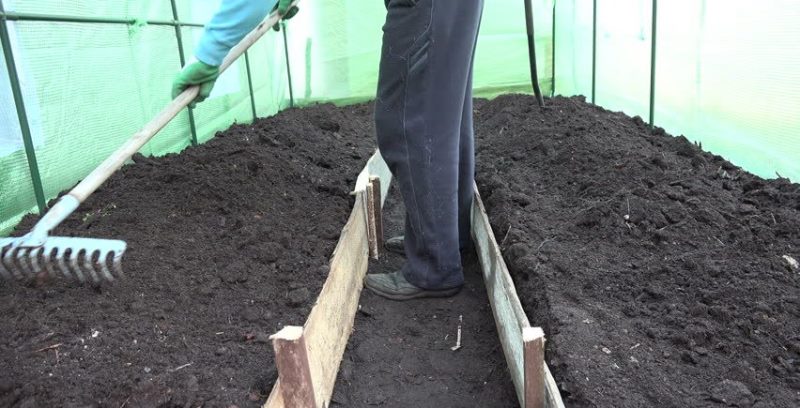
Soil preparation begins in autumn
They love to grow tomatoes where zucchini, cabbage, carrots and legumes were previously planted. Will not take root in place of eggplant, pepper and potatoes. Before transplanting a tomato, the soil is peeled (loosened and mixed), then the plowing is plowed, and harrowed in the spring (a process similar to peeling, but here the layer does not turn over).
For planting tomatoes in the soil, it is possible to use open ground or plant in a greenhouse. This usually happens in May or early June. A week before planting, the land is treated with special solutions that destroy pests, and then mineral fertilizers and humus are added to it. After all these procedures, the soil is dug up again.
Direct planting of seeds is carried out in the evening or in cloudy weather. For greater fertility, peat or manure is added to the soil and regularly fed with specialized mixtures that contain nitrogen, phosphorus and potassium. Seedlings are watered with warm water, then you can cover it with non-woven material so that in the future you do not pour tomatoes in large quantities.
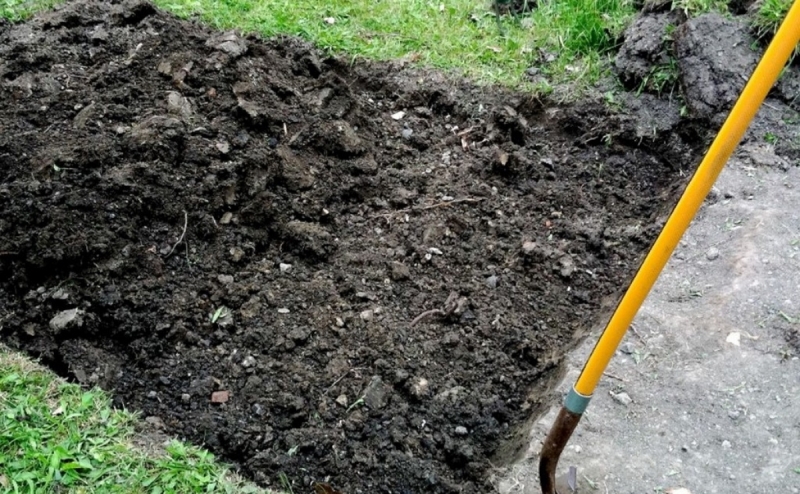
Seedlings are suitable for planting in the soil only if they reach a length of 20 cm and have a developed root system. There may be several reasons why the seeds did not germinate:
- A special variety of tomatoes, the germination of which is longer.
- Wrong temperature. During the day it should be about + 20ºС, and in the dark it should drop to + 15ºС.
- Poor quality of tomato seedlings.
- Waterlogging. It is necessary to start watering seedlings only after the first leaves appear on them.
Land for tomato seedlings (video)
The preliminary preparation of the soil for tomatoes in the greenhouse is somewhat different. It requires:
- Clear the ground. In order for the soil to breathe, it is necessary to first remove a variety of small debris.
- Sawdust. Sprinkle them abundantly on the ground, as they absorb excess nitrogen produced by manure and also slightly loosen the soil.
- Lime. It neutralizes acidity after rotting residues.
- Fresh manure. It will serve as a source of nutrition and provide heat for the tomatoes in the greenhouse.
- A new layer of earth is added along with ash and mineral fertilizers.
- The soil for seedlings of tomatoes is poured with hot water and covered with a film.
- Planting is possible within a week.
There is another option for preparing for further sowing. It is more expensive, but no less effective:
- Reeds are laid in the initial layer along with rotting branches.
- Next, sawdust (3 buckets) and urea (200 g) must be placed on the layer.
- Topped with lime.
- Next, ash, a little earth and mineral fertilizers are mixed.
- Everything alternates three more times.
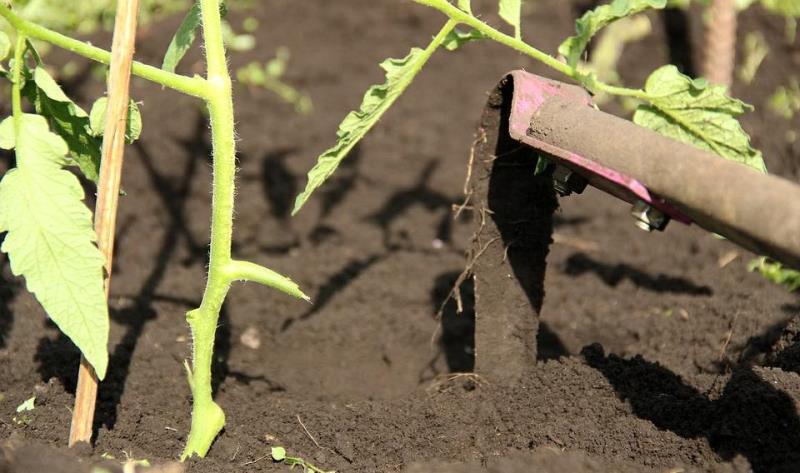
In addition to all known methods of planting in an open area and in a greenhouse, it is possible to grow a tomato in an apartment on a balcony. To do this, use special varieties of crop seeds (most often these are hybrid options). Here, preparing the soil for tomatoes has some nuances:
- the best option would be to choose a ready-made purchased soil, well suited for such purposes;
- mix: turf, peat and humus (preferably manure);
- mix: land from forest plantations (2 parts), peat and sand.
With further planting of tomatoes in a large clay pot, it is required to add a layer of gravel, and then the mixture prepared in advance, leaving about 2 cm for sowing. After that, the soil for tomatoes is additionally watered with a solution of potassium permanganate and the treated seeds are planted.
You can get seedlings without land, this method will be more convenient when planting at home. However, it is also possible when placing tomato seeds in open ground or in greenhouses. Work technology:
- Cut the plastic film 10 cm long.
- Put toilet paper moistened with water on it.
- Spread the seeds on top. Another layer of toilet paper and polyethylene is placed on top.
- The whole structure is rolled up and inserted into the glass with the seeds up.
- Water is poured to a level of 3-4 cm and placed on a windowsill or other place.
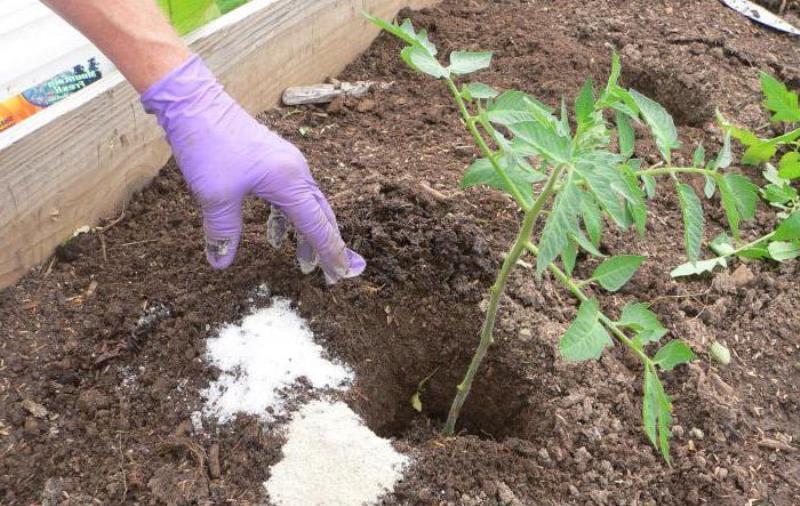
Preparing the soil for a tomato is a rather difficult task, but all efforts will pay off with the first successful harvest.
With this method, in a week the first shoots will appear for further sowing.
Preparing the soil for a tomato is a rather difficult task, but all efforts will pay off with the first successful harvest. The main thing is to strictly follow the instructions. We must not forget about watering and feeding plants.
